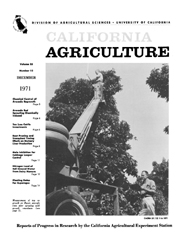


University of California
California Agriculture
|
|||
|
|||

Cover:
Measurement of top regrowth on Bacon avocado trees after spraying with growth retardants.
December 1971
Volume 25, Number 12 News and opinion |
|||
|
University of California, 1301 S. 46th St., Bldg. 478 Richmond, CA
|